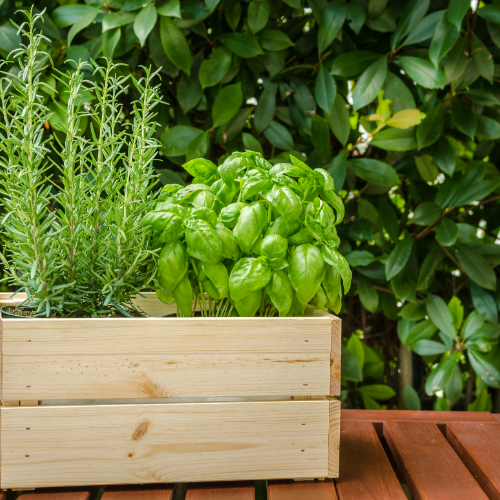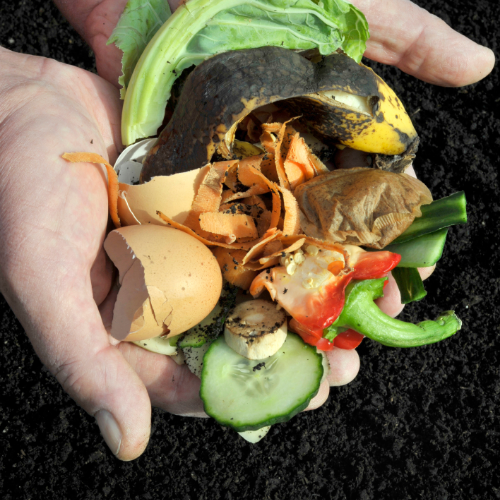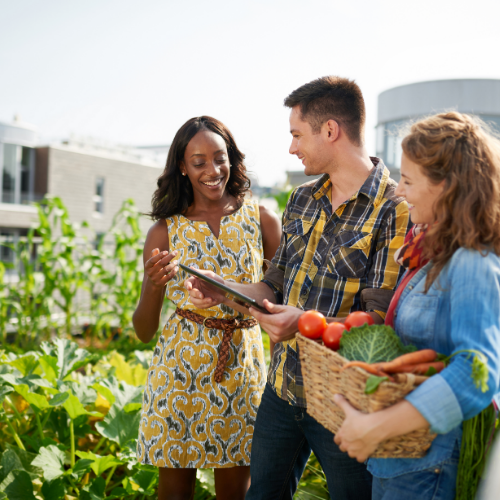FOOD
Our habits and lifestyles surrounding our food consumption and waste hold a key stake in our carbon footprints. Food requires land, water and energy from cultivation, harvesting, production, packaging, refrigeration, transport to the wholesaler, transport to the customer and waste disposal.
To reduce your food carbon footprint, consider the following suggestions which will be beneficial to individuals, households, and businesses.
Read More
1. Grow Your Own Food
Depending on your geographical region and climate, its unlikely you can grow 100% of your food needs. However, everyone can grow something, and you don’t need a lot of excess space to do so.
Consider using some garden space to create your own vegetable garden. If you live in an apartment, consider growing herbs in window boxes. If you are a business with adequate space, consider starting an employee or community garden.
If community gardens are already available in your area, take advantage and give it a go. Growing your own produce has been linked to reduction in stress and increases in the nutritional density of your food. Ultimately, leading to a healthier diet and body.
Growing even one aspect of your diet can lower your carbon footprint due to the decrease in plastic packaging needed, pesticides and fertilizers, and water required to feed yourself and your family. Plus, it cuts out the associated transport by vehicle needed to distribute food products to supermarkets.
2. Buy Local
If growing and gardening isn’t for you, you can try and source locally grown products. Buying from local sources not only helps reduce your carbon footprint as above, it creates local jobs as you are spending your money closer to home. It also builds a greater sense of community and belonging.
3. Buy In Season
We have become accustomed to having everything all the time. We forget that plants don’t work that way. Fruit and vegetables are seasonal, air freighting asparagus or grapes halfway round the world so you can have them 365 days a year is not environmentally feasible. Consider and audit your food when you’re buying it, where did it come from? Eat seasonally, there is always a fabulous, fresh, local and inexpensive range of fruit and vegetables ready to devour. This seasonal offering reaches your table with a fraction of the environmental cost associated with air flown, refrigerated exotic alternatives.
4. Monitor Your Food Waste
Hundreds of millions of kilos of food are wasted each year, either before it reaches the supermarket shelves, or due to our leftovers and spoiled household food. It is our nature to over consume and over purchase food when shopping for groceries. However, this habit causes us to waste a significant portion of our food each week or month.
When we grocery shop, if we purchase smaller amounts and more frequently this significantly reduces waste.
Decomposing food releases a greenhouse gas (GHG) called methane, which is 24 times more harmful to global warming than carbon dioxide, it is much more harmful to the planet’s atmosphere as it traps heat more efficiently than carbon dioxide.
The best way to avoid this is by reducing your food waste.
5. Compost
For the leftovers and spoiled food that remain, the best option is to compost it. You can set up a composter at home and there are programs available in some councils for community composting. Another option is to seek out a community garden that composts, as most have compost bins or piles on site. Composting is a great alternative to throwing food waste out and. Composting allows for more oxygen to reach decomposing foods, which slows down the rate of greenhouse gases released, and produces rich nutrient fertiliser which can then be used in your garden or on a commercial scale for further food production.
Councils and industry are developing curb side recycling to take household food waste and garden waste to use them as a fuel source and generate electricity. These facilities are called Biogas Energy Projects.
Read Less




Food




Our habits and lifestyles surrounding our food consumption and waste hold a key stake in our carbon footprints. Food requires land, water and energy from cultivation, harvesting, production, packaging, refrigeration, transport to the wholesaler, transport to the customer and waste disposal.
To reduce your food carbon footprint, consider the following suggestions which will be beneficial to individuals, households, and businesses.
Read More
1. Grow Your Own Food
Depending on your geographical region and climate, its unlikely you can grow 100% of your food needs. However, everyone can grow something, and you don’t need a lot of excess space to do so.
Consider using some garden space to create your own vegetable garden. If you live in an apartment, consider growing herbs in window boxes. If you are a business with adequate space, consider starting an employee or community garden.
If community gardens are already available in your area, take advantage and give it a go. Growing your own produce has been linked to reduction in stress and increases in the nutritional density of your food. Ultimately, leading to a healthier diet and body.
Growing even one aspect of your diet can lower your carbon footprint due to the decrease in plastic packaging needed, pesticides and fertilizers, and water required to feed yourself and your family. Plus, it cuts out the associated transport by vehicle needed to distribute food products to supermarkets.
2. Buy Local
If growing and gardening isn’t for you, you can try and source locally grown products. Buying from local sources not only helps reduce your carbon footprint as above, it creates local jobs as you are spending your money closer to home. It also builds a greater sense of community and belonging.
3. Buy In Season
We have become accustomed to having everything all the time. We forget that plants don’t work that way. Fruit and vegetables are seasonal, air freighting asparagus or grapes halfway round the world so you can have them 365 days a year is not environmentally feasible. Consider and audit your food when you’re buying it, where did it come from? Eat seasonally, there is always a fabulous, fresh, local and inexpensive range of fruit and vegetables ready to devour. This seasonal offering reaches your table with a fraction of the environmental cost associated with air flown, refrigerated exotic alternatives.
4. Monitor Your Food Waste
Hundreds of millions of kilos of food are wasted each year, either before it reaches the supermarket shelves, or due to our leftovers and spoiled household food. It is our nature to over consume and over purchase food when shopping for groceries. However, this habit causes us to waste a significant portion of our food each week or month.
When we grocery shop, if we purchase smaller amounts and more frequently this significantly reduces waste.
Decomposing food releases a greenhouse gas (GHG) called methane, which is 24 times more harmful to global warming than carbon dioxide, it is much more harmful to the planet’s atmosphere as it traps heat more efficiently than carbon dioxide.
The best way to avoid this is by reducing your food waste.
5. Compost
For the leftovers and spoiled food that remain, the best option is to compost it. You can set up a composter at home and there are programs available in some councils for community composting. Another option is to seek out a community garden that composts, as most have compost bins or piles on site. Composting is a great alternative to throwing food waste out and. Composting allows for more oxygen to reach decomposing foods, which slows down the rate of greenhouse gases released, and produces rich nutrient fertiliser which can then be used in your garden or on a commercial scale for further food production.
Councils and industry are developing curb side recycling to take household food waste and garden waste to use them as a fuel source and generate electricity. These facilities are called Biogas Energy Projects.
Read Less
Food
Our habits and lifestyles surrounding our food consumption and waste hold a key stake in our carbon footprints. Food requires land, water and energy from cultivation, harvesting, production, packaging, refrigeration, transport to the wholesaler, transport to the customer and waste disposal.
To reduce your food carbon footprint, consider the following suggestions which will be beneficial to individuals, households, and businesses.
Read More
1. Grow Your Own Food
Depending on your geographical region and climate, its unlikely you can grow 100% of your food needs. However, everyone can grow something, and you don’t need a lot of excess space to do so.
Consider using some garden space to create your own vegetable garden. If you live in an apartment, consider growing herbs in window boxes. If you are a business with adequate space, consider starting an employee or community garden.
If community gardens are already available in your area, take advantage and give it a go. Growing your own produce has been linked to reduction in stress and increases in the nutritional density of your food. Ultimately, leading to a healthier diet and body.
Growing even one aspect of your diet can lower your carbon footprint due to the decrease in plastic packaging needed, pesticides and fertilizers, and water required to feed yourself and your family. Plus, it cuts out the associated transport by vehicle needed to distribute food products to supermarkets.
2. Buy Local
If growing and gardening isn’t for you, you can try and source locally grown products. Buying from local sources not only helps reduce your carbon footprint as above, it creates local jobs as you are spending your money closer to home. It also builds a greater sense of community and belonging.
3. Buy In Season
We have become accustomed to having everything all the time. We forget that plants don’t work that way. Fruit and vegetables are seasonal, air freighting asparagus or grapes halfway round the world so you can have them 365 days a year is not environmentally feasible. Consider and audit your food when you’re buying it, where did it come from? Eat seasonally, there is always a fabulous, fresh, local and inexpensive range of fruit and vegetables ready to devour. This seasonal offering reaches your table with a fraction of the environmental cost associated with air flown, refrigerated exotic alternatives.
4. Monitor Your Food Waste
Hundreds of millions of kilos of food are wasted each year, either before it reaches the supermarket shelves, or due to our leftovers and spoiled household food. It is our nature to over consume and over purchase food when shopping for groceries. However, this habit causes us to waste a significant portion of our food each week or month.
When we grocery shop, if we purchase smaller amounts and more frequently this significantly reduces waste.
Decomposing food releases a greenhouse gas (GHG) called methane, which is 24 times more harmful to global warming than carbon dioxide, it is much more harmful to the planet’s atmosphere as it traps heat more efficiently than carbon dioxide.
The best way to avoid this is by reducing your food waste.
5. Compost
For the leftovers and spoiled food that remain, the best option is to compost it. You can set up a composter at home and there are programs available in some councils for community composting. Another option is to seek out a community garden that composts, as most have compost bins or piles on site. Composting is a great alternative to throwing food waste out and. Composting allows for more oxygen to reach decomposing foods, which slows down the rate of greenhouse gases released, and produces rich nutrient fertiliser which can then be used in your garden or on a commercial scale for further food production.
Councils and industry are developing curb side recycling to take household food waste and garden waste to use them as a fuel source and generate electricity. These facilities are called Biogas Energy Projects.
Read Less





Carbon Offset Advisory acknowledges the traditional owners and custodians of country throughout Australia and acknowledges their continuing connection to land, water and community.
We pay our respects to the people, the cultures and the elders past, present and emerging.

